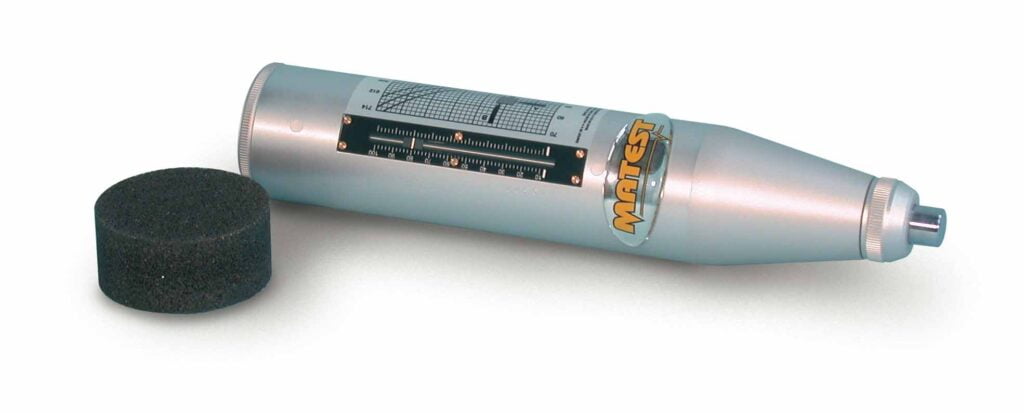The Rebound Hammer Test, also known as the Schmidt Hammer Test, is a non-destructive testing method widely employed in the construction industry for assessing the quality and strength of concrete structures.
Developed by Ernst O. Schmidt in the early 1950s, this test has become an integral part of quality control and quality assurance procedures in civil engineering and construction projects.
This article delves into the various aspects of the Rebound Hammer Test, exploring its applications, methodology, and significance in evaluating concrete strength.
I. Overview of Rebound Hammer Test:
The Rebound Hammer Test involves striking a concrete surface with a spring-loaded hammer and measuring the rebound velocity of the hammer upon impact.
This rebound value is correlated with the hardness and compressive strength of the concrete, providing valuable insights into the material’s structural integrity. The test is quick, cost-effective, and non-destructive, making it a preferred choice for on-site assessments.
II. Applications of Rebound Hammer Test:
- Quality Control in Construction: The Rebound Hammer Test is extensively used during construction to monitor and control the quality of concrete. Contractors and engineers can quickly assess the strength of freshly placed concrete, ensuring that it meets the specified design requirements.
- Structural Health Monitoring: For existing structures, the Rebound Hammer Test is employed to assess the in-situ strength of concrete elements. This is particularly crucial in evaluating the structural health of buildings, bridges, and other infrastructure over time.
- Damage Assessment: In cases of structural damage or distress, the Rebound Hammer Test can help identify weakened areas within concrete elements. By pinpointing zones of reduced strength, engineers can plan targeted repairs or rehabilitation strategies.
- Acceptance Testing: The test is often used as part of acceptance criteria for completed construction projects. It provides a rapid means of ensuring that the concrete has attained the desired strength before structures are put into service.
III. Methodology of Rebound Hammer Test:
- Preparation: Before conducting the test, the concrete surface should be clean and free from loose particles. It is essential to take multiple readings at different locations to obtain a representative assessment of the overall concrete strength.
- Calibration: Regular calibration of the rebound hammer is crucial to ensure accurate and reliable results. The rebound values are influenced by factors such as the type of concrete, surface finish, and testing conditions. Calibrating the hammer against a reference concrete surface helps account for these variables.
- Testing Procedure: The rebound hammer is held perpendicular to the test surface, and a firm, consistent impact is applied. The rebound distance is then measured by the device and recorded as a rebound number or rebound index. Several readings are typically taken and averaged to enhance the reliability of the results.
- Correlation with Compressive Strength: The rebound number obtained from the test is correlated with the compressive strength of concrete using conversion charts or equations specific to the concrete mix. This correlation is essential for interpreting the rebound values in terms of concrete strength.
IV. Significance of Rebound Hammer Test:
- Non-Destructive Nature: One of the key advantages of the Rebound Hammer Test is its non-destructive nature. Unlike traditional methods that involve core sampling, this test allows for strength assessment without causing damage to the structure.
- Rapid Assessment: The test provides quick results, making it suitable for on-site applications. This rapid assessment is particularly valuable in construction projects where timely decisions are crucial.
- Cost-Effective Quality Control: The Rebound Hammer Test is a cost-effective means of quality control, allowing construction professionals to identify and rectify potential issues before they escalate, thereby reducing the risk of costly repairs.
- In-Situ Strength Evaluation: By offering in-situ strength evaluation, the Rebound Hammer Test provides a more accurate representation of the actual conditions compared to laboratory tests on core samples. This is especially significant in assessing the performance of aged structures.
V. Limitations and Considerations:
- Surface Conditions: The test results may be influenced by the surface conditions of the concrete, including roughness, porosity, and moisture content. Special care should be taken to prepare the surface adequately.
- Influence of Aggregate Size: The presence of large aggregates may affect the accuracy of the rebound values. It is crucial to consider the aggregate size and distribution when interpreting test results.
- Depth of Assessment: The Rebound Hammer Test provides information about the concrete surface layer. For a comprehensive assessment of the entire structure, additional testing methods may be necessary.
- Calibration Frequency: Regular calibration of the rebound hammer is essential to account for wear and tear, ensuring the accuracy of the test results.
Conclusion:
The Rebound Hammer Test stands as a valuable tool in the arsenal of non-destructive testing methods, offering a quick and effective means of assessing the quality and strength of concrete.
Its widespread use in construction projects, structural health monitoring, and damage assessment underscores its importance in ensuring the durability and safety of concrete structures.
However, it is crucial to acknowledge its limitations and employ the test judiciously, complementing it with other testing methods for a comprehensive evaluation of concrete performance.
As technology advances, the Rebound Hammer Test continues to evolve, maintaining its relevance in the dynamic field of civil engineering.
To see other material construction prices, please see here.
To know other construction guides, tips, and methodology for beginners, veterans, and contractors, please see here.

